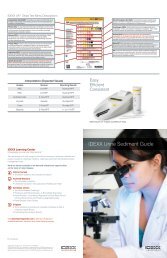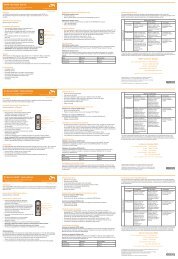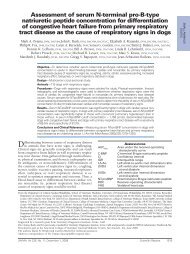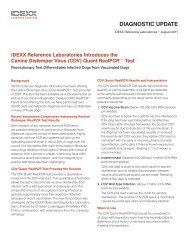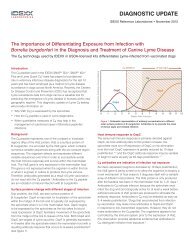SNAP 4Dx Plus Clinical Reference Guide - IDEXX Laboratories
SNAP 4Dx Plus Clinical Reference Guide - IDEXX Laboratories
SNAP 4Dx Plus Clinical Reference Guide - IDEXX Laboratories
You also want an ePaper? Increase the reach of your titles
YUMPU automatically turns print PDFs into web optimized ePapers that Google loves.
Every dog, every year<br />
For healthier pets and so much more. The benefits of vector-borne disease screening go far beyond the<br />
well-being of an individual pet. Adopting regular screening protocols at your practice can lead to a greater<br />
awareness and understanding of vector-borne disease in your community, while building the value of your<br />
practice with pet owners.<br />
Know more with every result<br />
With the <strong>SNAP</strong> ® <strong>4Dx</strong> ® <strong>Plus</strong> Test, a positive result can also be an indication<br />
of ticks and other pathogens in your area.<br />
Your patients<br />
Educating pet owners about the<br />
risk of vector-borne disease is an<br />
opportunity to stress the importance<br />
of screening and prevention.<br />
Your community<br />
Comprehensive annual screenings<br />
give you a current snapshot of how<br />
widespread certain diseases and tick<br />
species are in the area.<br />
Your practice<br />
Vector-borne disease screenings<br />
are the foundation of your practice’s<br />
preventive medicine programs and<br />
let you know what your patients are<br />
being exposed to over time, which<br />
leads to healthier patients and a<br />
stronger practice.<br />
When you use the<br />
<strong>SNAP</strong> ® <strong>4Dx</strong> ® <strong>Plus</strong> Test<br />
as a screening tool,<br />
you may<br />
detect antibodies to<br />
these pathogens<br />
Ehrlichia ewingii<br />
carried by<br />
these ticks<br />
Lone star tick<br />
Amblyomma<br />
americanum<br />
that may also transmit<br />
other infections to<br />
dogs and people<br />
Ehrlichia chaffeensis<br />
Tularemia<br />
Rocky Mountain spotted fever<br />
STARI<br />
Geographic tick<br />
distribution as<br />
of 2011<br />
Anaplasma<br />
phagocytophilum<br />
Borrelia burgdorferi<br />
(Lyme disease)<br />
Deer tick or<br />
black-legged tick<br />
Ixodes scapularis<br />
Ixodes pacificus<br />
Bartonella spp.<br />
Babesia spp.<br />
Ehrlichia canis<br />
Anaplasma platys<br />
Brown dog tick<br />
Rhipicephalus<br />
sanguineus<br />
Babesia spp.<br />
Rocky Mountain spotted fever<br />
Ehrlichia canis<br />
American dog tick<br />
Dermacentor<br />
variabilis<br />
Rocky Mountain spotted fever<br />
Tularemia






